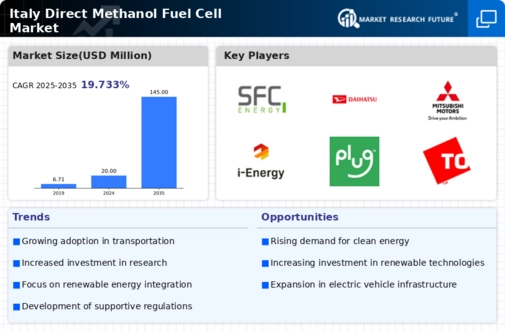Advancements in Fuel Cell Technology
Technological advancements in fuel cell technology are playing a crucial role in shaping the direct methanol-fuel-cell market. Innovations in materials and design are leading to improved efficiency and reduced costs, making fuel cells more competitive with traditional energy sources. In 2025, the average cost of fuel cell systems is projected to decrease by 30%, driven by advancements in manufacturing processes and economies of scale. These improvements are likely to enhance the attractiveness of the direct methanol-fuel-cell market for various applications, including stationary power generation and transportation. As technology continues to evolve, the market is expected to expand, offering new opportunities for businesses and consumers alike.
Government Incentives for Clean Energy
The Italian government actively promotes the adoption of clean energy technologies, including the direct methanol-fuel-cell market. Various incentives, such as tax breaks and subsidies, are available for companies investing in renewable energy solutions. In 2025, the government allocated approximately €500 million to support research and development in fuel cell technologies. This financial backing is expected to stimulate growth in the direct methanol-fuel-cell market, encouraging businesses to transition from traditional energy sources to more sustainable options. Furthermore, the European Union's commitment to reducing greenhouse gas emissions by at least 55% by 2030 aligns with Italy's energy policies, creating a favorable environment for the direct methanol-fuel-cell market to thrive.
Environmental Regulations and Standards
Italy's stringent environmental regulations are significantly influencing the direct methanol-fuel-cell market. The country has implemented various laws aimed at reducing carbon emissions and promoting cleaner technologies. For instance, the Italian Ministry of the Environment has set ambitious targets for reducing air pollution, which has led to increased investments in fuel cell technologies. In 2025, it is estimated that compliance with these regulations will drive a 20% increase in the adoption of fuel cells across various sectors. This regulatory landscape creates a robust demand for the direct methanol-fuel-cell market, as businesses seek to align with environmental standards while enhancing their operational efficiency.
Growing Interest in Energy Independence
The quest for energy independence is becoming increasingly relevant in Italy, thereby impacting the direct methanol-fuel-cell market. As global energy prices fluctuate, there is a growing emphasis on developing domestic energy sources. The direct methanol-fuel-cell market offers a pathway to utilize locally sourced methanol, which can be produced from various feedstocks, including agricultural waste. This potential for local production not only enhances energy security but also reduces reliance on imported fossil fuels. In 2025, it is anticipated that the market will see a surge in investments aimed at establishing methanol production facilities, further bolstering the direct methanol-fuel-cell market.
Rising Demand for Portable Power Solutions
The increasing need for portable power solutions in Italy is driving the direct methanol-fuel-cell market. As consumers and businesses seek efficient and reliable energy sources for mobile applications, fuel cells are emerging as a viable alternative. The market for portable fuel cells is projected to grow at a CAGR of 15% from 2025 to 2030. This growth is fueled by the demand for lightweight and compact energy sources in sectors such as consumer electronics, military, and emergency services. The direct methanol-fuel-cell market is well-positioned to meet these needs, offering advantages such as high energy density and quick refueling times, which are essential for portable applications.




















Leave a Comment